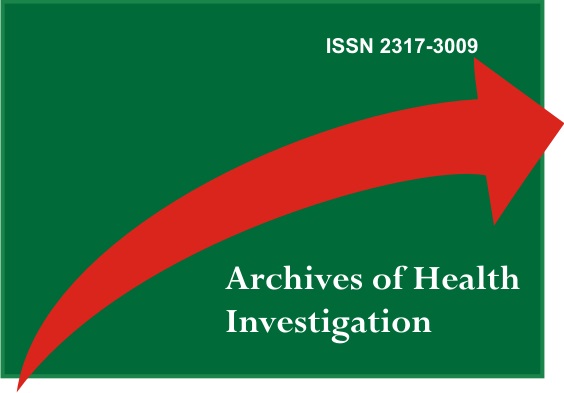Modificación del fenotipo periodontal por técnica mínimamente invasiva
DOI:
https://doi.org/10.21270/archi.v10i5.4982Palabras clave:
Periodoncia, Recesión Gingival, Estética DentalResumen
El objetivo es describir la modificación de la sonrisa a través de la técnica de túnel con injerto de tejido conectivo en la cobertura de la raíz de Miller clase I. Un paciente masculino de 24 años fue derivado al tratamiento de recesión gingival que se encontró en el examen clínico y radiográfico en el elemento 23, cuya altura era de 2 mm, ancho de 3 mm y mucosa queratinizada de 2 mm. En la consulta, se decidió cubrirlo con un injerto de tejido subepitelial tunelizado. La anestesia local y la incisión intra-sulcular se realizaron para poder separar posteriormente la encía. Con la máquina de tunelización, se preparó un túnel de periostio mucoso y se realizó una terapia mecánica con una cureta Gracey 5/6 y una sustancia química con ácido cítrico al 10% durante 3 minutos, para hacer factible la adecuación del injerto. El injerto de 1,5 mm de grosor se retiró del paladar en una incisión lineal, entre el elemento distal 13 y el elemento mesial 16, a 3 mm del margen gingival. El tejido se colocó en el sitio de recesión y se mantuvo mediante suturas. Se hizo cemento quirúrgico, se le ordenó no limpiar la región y enjuagar con digluconato de clorhexidina al 0,12%. La planificación adecuada asociada con una excelente técnica de ejecución y previsibilidad fueron herramientas fundamentales para el éxito en cubrir toda la recesión y aumentar la mucosa queratinizada.
Descargas
Citas
Saadoun AP. Current trends in gingival recession coverage--part I: the tunnel connective tissue graft. Pract Proced Aesthet Dent. 2006;18(7):433-8; quiz 440.
Baker P, Spedding C. The aetiology of gingival recession. Dent Update. 2002;29(2):59-62.
Rebele SF, Zuhr O, Schneider D, Jung RE, Hürzeler MB. Tunnel technique with connective tissue graft versus coronally advanced flap with enamel matrix derivative for root coverage: a RCT using 3D digital measuring methods. Part II. Volumetric studies on healing dynamics and gingival dimensions. J Clin Periodontol. 2014; 41(6):593-603.
Tsourounakis I, Sweidan C, Palaiologou AA, Maney P. Coverage of isolated, severe gingival recession: A modified technique. Clin Adv Periodontics; 2014;4:148-53.
Rees JS, Addy M. A cross-sectional study of dentine hypersensitivity. J Clin Periodontol. 2002;29(11):997-1003.
Ribeiro FS, Zandim DL, Pontes AE, Mantovani RV, Sampaio JE, Marcantonio E. Tunnel technique with a surgical maneuver to increase the graft extension: case report with a 3-year follow-up. J Periodontol. 2008;79(4):753-58.
Bouchard P, Malet J, Borghetti A. Decision-making in aesthetics: root coverage revisited. Periodontol 2000. 2001;27:97-120.
Singh J, Rathod VJ, Rao PR, Patil AA, Langade DG, Singh RK. Correlation of gingival thickness with gingival width, probing depth, and papillary fill in maxillary anterior teeth in students of a dental college in Navi Mumbai. Contemp Clin Dent. 2016;7(4):535-38.
Stimmelmayr M, Allen EP, Gernet W, Edelhoff D, Beuer F, Schlee M et al. Treatment of gingival recession in the anterior mandible using the tunnel technique and a combination epithelialized-subepithelial connective tissue graft-a case series. Int J Periodontics Restorative Dent. 2011;31(2):165-73.
Zuhr O,Rebele SF, Schneider D, Jung RE, Hürzeler MB. Tunnel technique with connective tissue graft versus coronally advanced flap with enamel matrix derivative for root coverage: a RCT using 3D digital measuring methods. Part I. Clinical and patient-centred outcomes. J Clin Periodontol. 2014;41(6):582-92.
Miller PD Jr. A classification of marginal tissue recession. Int J Periodontics Restorative Dent. 1985;5(2):8-13.
Dani S, Dhage A, Gundannavar G. The pouch and tunnel technique for management of multiple gingival recession defects. J Indian Soc Periodontol. 2014;18(6):776-80.
Han JS, John V, Blanchard SB, Kowolik MJ, Eckert GJ. Changes in gingival dimensions following connective tissue grafts for root coverage: comparison of two procedures. J Periodontol. 2008;79(8):1346-54.
Zabalegui I, Sicilia A, Cambra J, Gil J, Sanz M. Treatment of multiple adjacent gingival recessions with the tunnel subepithelial connective tissue graft: a clinical report. Int J Periodontics Restorative Dent. 1999;19(2): 199-206.
Shanelec DA. Periodontal microsurgery. J Esthet Restor Dent. 2003;15(7):402-8.
Burkhardt R, Lang NP. Coverage of localized gingival recessions: comparison of micro- and macrosurgical techniques. J Clin Periodontol. 2005;32(3):287-93.
Salama H, Salama M, Garber D. The tunnel technique in the periodontal plastic treatment of multiple adjacent gingival recession defects: A review. Inside Dentistry. 2008;4:78-81.
Zuhr O, Fickl S, Wachtel H, Bolz W, Hürzeler MB. Covering of gingival recessions with a modified microsurgical tunnel technique: case report. Int J Periodontics Restorative Dent. 2007;27(5):457-63.
Allen EP. Subpapillary continuous sling suturing method for soft tissue grafting with the tunneling technique. Int J Periodontics Restorative Dent. 2010;30(5):479-85.
Pfeifer JS. The reaction of alveolar bone to flap procedures in man. Periodontics. 1965;3:135-40.
Pazmiño VFC, Rodas MAR, Cáceres CDB, Duarte GGR, Azuaga MVC, de Paula BL et al. Clinical Comparison of the Subepithelial Connective Tissue versus Platelet-Rich Fibrin for the Multiple Gingival Recession Coverage on Anterior Teeth Using the Tunneling Technique. Case Rep Dent. 2017; 2017:4949710.
Sa TM, Cruz JHA, Guênes GMT, Almeida MSC, Medeiros LADM, Figueiredo CHMC. A importância da anatomia e escultura dental para prática de procedimentos clínicos odontológicos. Arch Health Invest. 2018;7; (Spec Iss 7):6.


